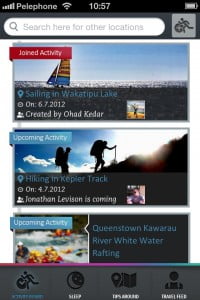There is something thrilling about traveling with no set itinerary, to land in an unknown city with nothing but your guidebook to lead the way.
But the setback with guidebooks is they are not updated in real-time, meaning they might lead you to a hotel, which in the meantime has been turned into a restaurant. Places are in constant states of fluctuation, whereas guidebooks are not.
A travel app, with real-time updates, therefore seems like a practical idea (if you have cheap internet access, of course.)
WeTrip is a new social travel platform recently released to the App Store.
Related Story:
The Israeli application, formerly known as Backpack Network, allows travelers to access real-time social-driven feedback and information about where to visit, what to do and where to stay, as well as where to find like-minded people to travel with.
Using the mobile application or website, travelers can access and write tips and feedback and contact others traveling in the same area.
Ohad Kedar, co-founder and CEO, tells NoCamels about the circumstances that brought him to come up with the idea: “After graduating and having my previous venture reaching an end, I decided to travel for a while, before embarking on the next challenge. I was traveling for six weeks before I realized everything was exactly the same as it was five years ago, when I had first gone travelling. It didn’t make sense, the world has developed so much, people travel with iPads and laptops, but little had changed in terms of travel information.”
He adds: “The travellers we are targeting, the youth travel market aged 16-29, usually travel for longer periods and don’t plan so much in advance, so they consume most of the information on the go. Most of the services that are available for travelers today focus on travel planning, like where to sleep and eat. So whereas other companies focus on the means to travel, we focus on why we want to travel in the first place, and that is to see and do things. The application’s focus is on travel activities.”
See what’s trendy at the moment
WeTrip sorts information from various social network platforms, such as Facebook and Foursquare, and gathers it into a real-time information database. Every user can add content to the platform, which includes information about where they are and what they are doing, in addition to feedback and tips.
“The aim is to show what is popular now, what people are doing and what they like or dislike in the moment, rather than a few months later when things may have changed.”
Sign up for our free weekly newsletter
SubscribeA flagging system, where people can flag abusive or inappropriate content is available and WeTrip hopes to hire a content/community manager that will be responsible for monitoring user-created content.
The iPhone app requires Facebook authentication. Once users logs in, they are connected to their social graph. When looking for travel attractions or recommendations by travelers – information from all travelers nearby is visible to all users. The app highlights the information that is socially connected to the user – for example, if the recommendation comes from a friend.
“We are working right now on our web application, to serve all non-iPhone users. The experience is very similar to the iPhone app, with more exploration features that would also help travelers in planning their upcoming trip,” says Kedar. The web application will also have exploration features that do not require Facebook authentication, and users will have to authenticate if they wish to get personal information.
In addition to information uploaded by users, WeTrip collaborates with Viator and AdventureLink, two trip and activity booking platforms, which have already collected a list of about 25,000 travel attractions that people can book through the app.
The app’s official launch is scheduled for September, at the World Youth and Student Travel Conference – the biggest industry event for the youth travel market.
“Our goal is to have about 20,000 active users by the end of the first year, and we are essentially waiting for the launch for more people to become aware of the app,” says Kedar. He adds that currently most travel services have about 5,000-10,000 active users, while Gogobot – a service similar to WeTrip- has about 100,000 users.
Finding internet connections
One challenge for WeTrip is that internet connection is necessary to use the application or website. Kedar says the youth market has a stronger tendency to travel with internet-connected devices and believes that in places where there might not be WiFi, users will still be able to access the web from another source.
Lomgi Studios, the company behind the app, was founded by Omer Amsel, Ohad Kedar, and Jonathan Levison in September2011. The three entered The Junction in Tel Aviv – a workspace for entrepreneurs supported by Genesis Partners.
The initial funding of the company came from family and friends, and the team is currently in the process of additional fundraising in hopes of expanding the company. They plan to continue working with affiliates, which has proven successful in a collaboration with Minihostels.com, the largest hostel reservation service in Latin America. WeTrip says it is in the process of negotiating affiliations with similar services in Australia and New Zealand.
Photo by Stig Nygaard
Related posts

Editors’ & Readers’ Choice: 10 Favorite NoCamels Articles

Forward Facing: What Does The Future Hold For Israeli High-Tech?

Impact Innovation: Israeli Startups That Could Shape Our Future






Facebook comments